Strategic Analysis of Mark & Spencer's Business Strategy Report
VerifiedAdded on 2020/10/23
|10
|2796
|463
Report
AI Summary
This report provides a comprehensive analysis of Mark & Spencer's business strategy, focusing on its competitive forces and market position. It begins with an introduction to business strategy and the chosen organization, Mark & Spencer, a British multinational retailer. The report applies Porter's Five Forces model to evaluate the competitive landscape, including industry rivalry, the threat of new entrants, and the bargaining power of buyers and suppliers. Based on this analysis, the report devises appropriate strategies for improving M&S's competitive edge, such as product differentiation and growth and expansion strategies. Furthermore, it implements various business theories and models, including Porter's generic strategies (cost leadership, differentiation, and focus), to interpret strategic planning for the organization. The report concludes with a strategic management plan, outlining tangible and tactical strategic priorities and objectives, such as enhancing business sales through innovative strategies and the implementation of advanced equipment for improved production practices.
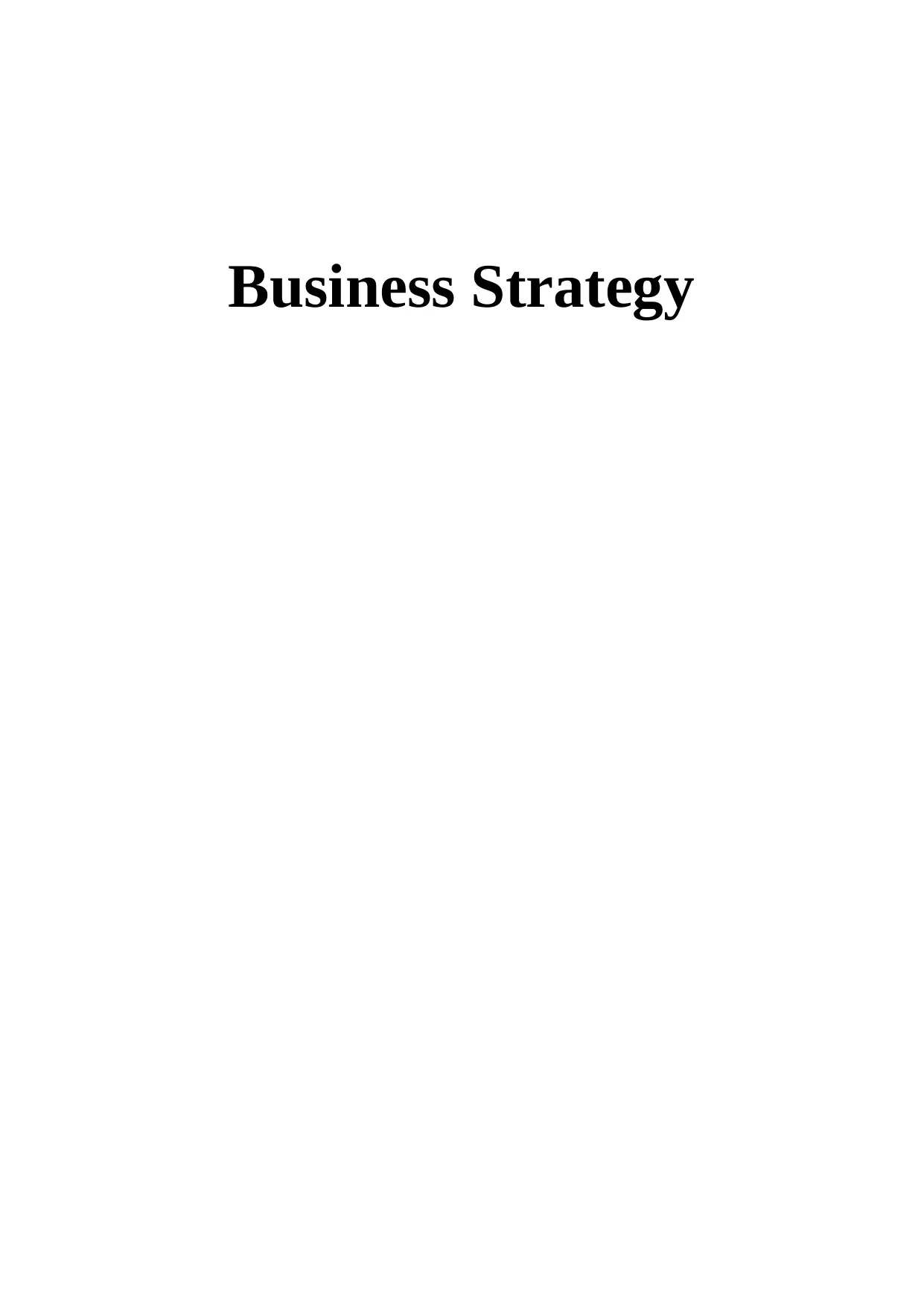
Business Strategy
Paraphrase This Document
Need a fresh take? Get an instant paraphrase of this document with our AI Paraphraser
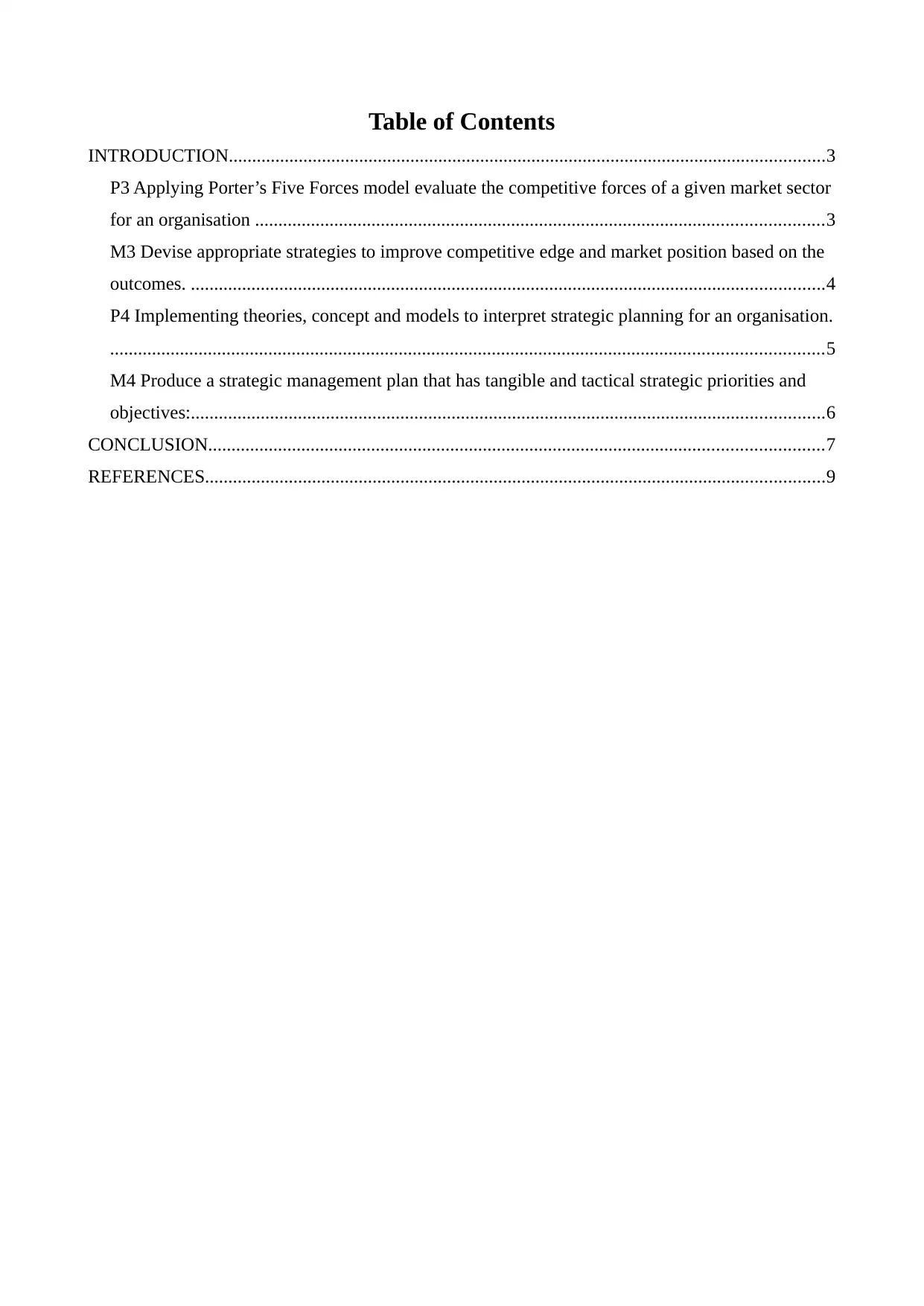
Table of Contents
INTRODUCTION................................................................................................................................3
P3 Applying Porter’s Five Forces model evaluate the competitive forces of a given market sector
for an organisation ..........................................................................................................................3
M3 Devise appropriate strategies to improve competitive edge and market position based on the
outcomes. ........................................................................................................................................4
P4 Implementing theories, concept and models to interpret strategic planning for an organisation.
.........................................................................................................................................................5
M4 Produce a strategic management plan that has tangible and tactical strategic priorities and
objectives:........................................................................................................................................6
CONCLUSION....................................................................................................................................7
REFERENCES.....................................................................................................................................9
INTRODUCTION................................................................................................................................3
P3 Applying Porter’s Five Forces model evaluate the competitive forces of a given market sector
for an organisation ..........................................................................................................................3
M3 Devise appropriate strategies to improve competitive edge and market position based on the
outcomes. ........................................................................................................................................4
P4 Implementing theories, concept and models to interpret strategic planning for an organisation.
.........................................................................................................................................................5
M4 Produce a strategic management plan that has tangible and tactical strategic priorities and
objectives:........................................................................................................................................6
CONCLUSION....................................................................................................................................7
REFERENCES.....................................................................................................................................9
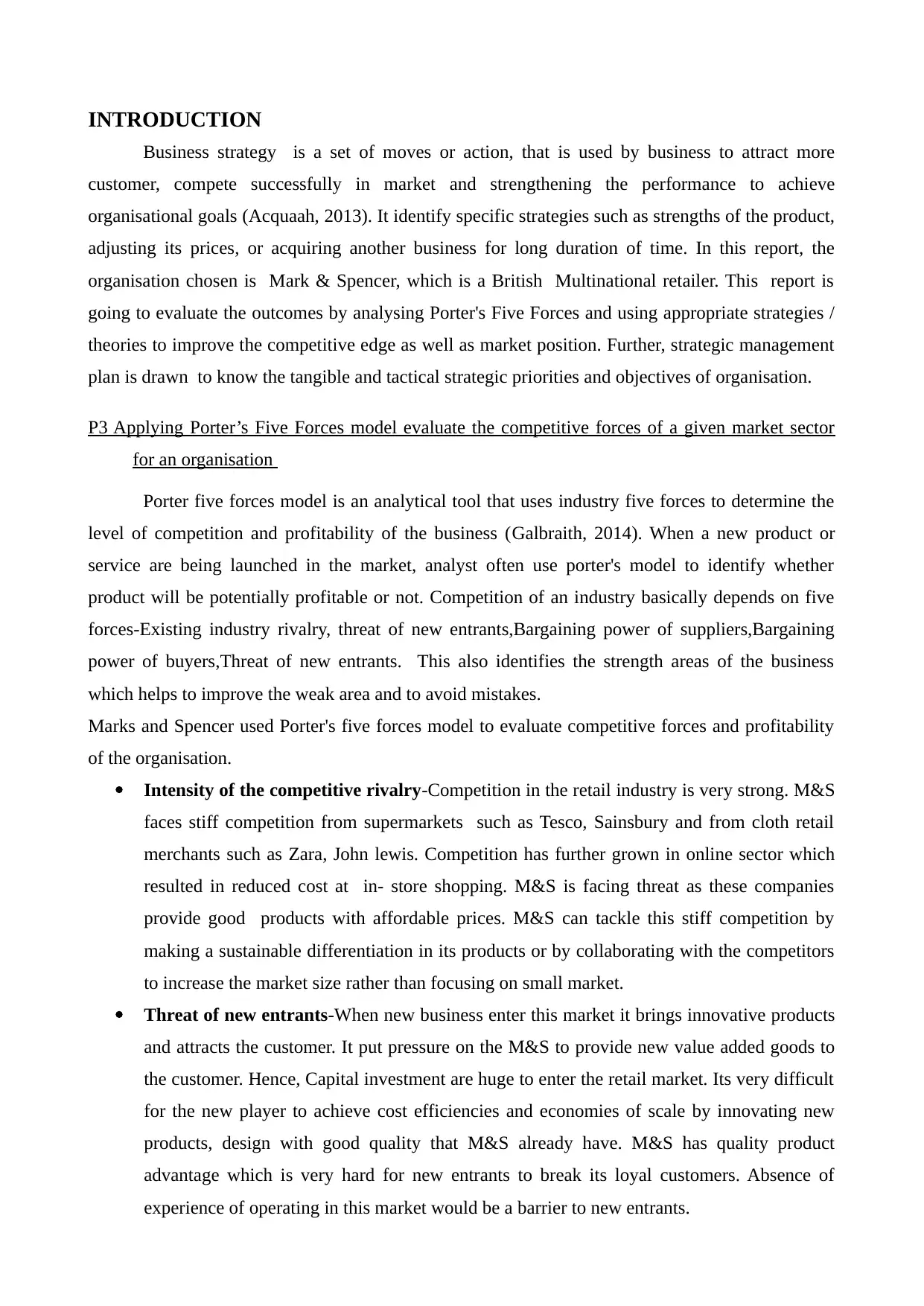
INTRODUCTION
Business strategy is a set of moves or action, that is used by business to attract more
customer, compete successfully in market and strengthening the performance to achieve
organisational goals (Acquaah, 2013). It identify specific strategies such as strengths of the product,
adjusting its prices, or acquiring another business for long duration of time. In this report, the
organisation chosen is Mark & Spencer, which is a British Multinational retailer. This report is
going to evaluate the outcomes by analysing Porter's Five Forces and using appropriate strategies /
theories to improve the competitive edge as well as market position. Further, strategic management
plan is drawn to know the tangible and tactical strategic priorities and objectives of organisation.
P3 Applying Porter’s Five Forces model evaluate the competitive forces of a given market sector
for an organisation
Porter five forces model is an analytical tool that uses industry five forces to determine the
level of competition and profitability of the business (Galbraith, 2014). When a new product or
service are being launched in the market, analyst often use porter's model to identify whether
product will be potentially profitable or not. Competition of an industry basically depends on five
forces-Existing industry rivalry, threat of new entrants,Bargaining power of suppliers,Bargaining
power of buyers,Threat of new entrants. This also identifies the strength areas of the business
which helps to improve the weak area and to avoid mistakes.
Marks and Spencer used Porter's five forces model to evaluate competitive forces and profitability
of the organisation.
Intensity of the competitive rivalry-Competition in the retail industry is very strong. M&S
faces stiff competition from supermarkets such as Tesco, Sainsbury and from cloth retail
merchants such as Zara, John lewis. Competition has further grown in online sector which
resulted in reduced cost at in- store shopping. M&S is facing threat as these companies
provide good products with affordable prices. M&S can tackle this stiff competition by
making a sustainable differentiation in its products or by collaborating with the competitors
to increase the market size rather than focusing on small market.
Threat of new entrants-When new business enter this market it brings innovative products
and attracts the customer. It put pressure on the M&S to provide new value added goods to
the customer. Hence, Capital investment are huge to enter the retail market. Its very difficult
for the new player to achieve cost efficiencies and economies of scale by innovating new
products, design with good quality that M&S already have. M&S has quality product
advantage which is very hard for new entrants to break its loyal customers. Absence of
experience of operating in this market would be a barrier to new entrants.
Business strategy is a set of moves or action, that is used by business to attract more
customer, compete successfully in market and strengthening the performance to achieve
organisational goals (Acquaah, 2013). It identify specific strategies such as strengths of the product,
adjusting its prices, or acquiring another business for long duration of time. In this report, the
organisation chosen is Mark & Spencer, which is a British Multinational retailer. This report is
going to evaluate the outcomes by analysing Porter's Five Forces and using appropriate strategies /
theories to improve the competitive edge as well as market position. Further, strategic management
plan is drawn to know the tangible and tactical strategic priorities and objectives of organisation.
P3 Applying Porter’s Five Forces model evaluate the competitive forces of a given market sector
for an organisation
Porter five forces model is an analytical tool that uses industry five forces to determine the
level of competition and profitability of the business (Galbraith, 2014). When a new product or
service are being launched in the market, analyst often use porter's model to identify whether
product will be potentially profitable or not. Competition of an industry basically depends on five
forces-Existing industry rivalry, threat of new entrants,Bargaining power of suppliers,Bargaining
power of buyers,Threat of new entrants. This also identifies the strength areas of the business
which helps to improve the weak area and to avoid mistakes.
Marks and Spencer used Porter's five forces model to evaluate competitive forces and profitability
of the organisation.
Intensity of the competitive rivalry-Competition in the retail industry is very strong. M&S
faces stiff competition from supermarkets such as Tesco, Sainsbury and from cloth retail
merchants such as Zara, John lewis. Competition has further grown in online sector which
resulted in reduced cost at in- store shopping. M&S is facing threat as these companies
provide good products with affordable prices. M&S can tackle this stiff competition by
making a sustainable differentiation in its products or by collaborating with the competitors
to increase the market size rather than focusing on small market.
Threat of new entrants-When new business enter this market it brings innovative products
and attracts the customer. It put pressure on the M&S to provide new value added goods to
the customer. Hence, Capital investment are huge to enter the retail market. Its very difficult
for the new player to achieve cost efficiencies and economies of scale by innovating new
products, design with good quality that M&S already have. M&S has quality product
advantage which is very hard for new entrants to break its loyal customers. Absence of
experience of operating in this market would be a barrier to new entrants.
⊘ This is a preview!⊘
Do you want full access?
Subscribe today to unlock all pages.

Trusted by 1+ million students worldwide
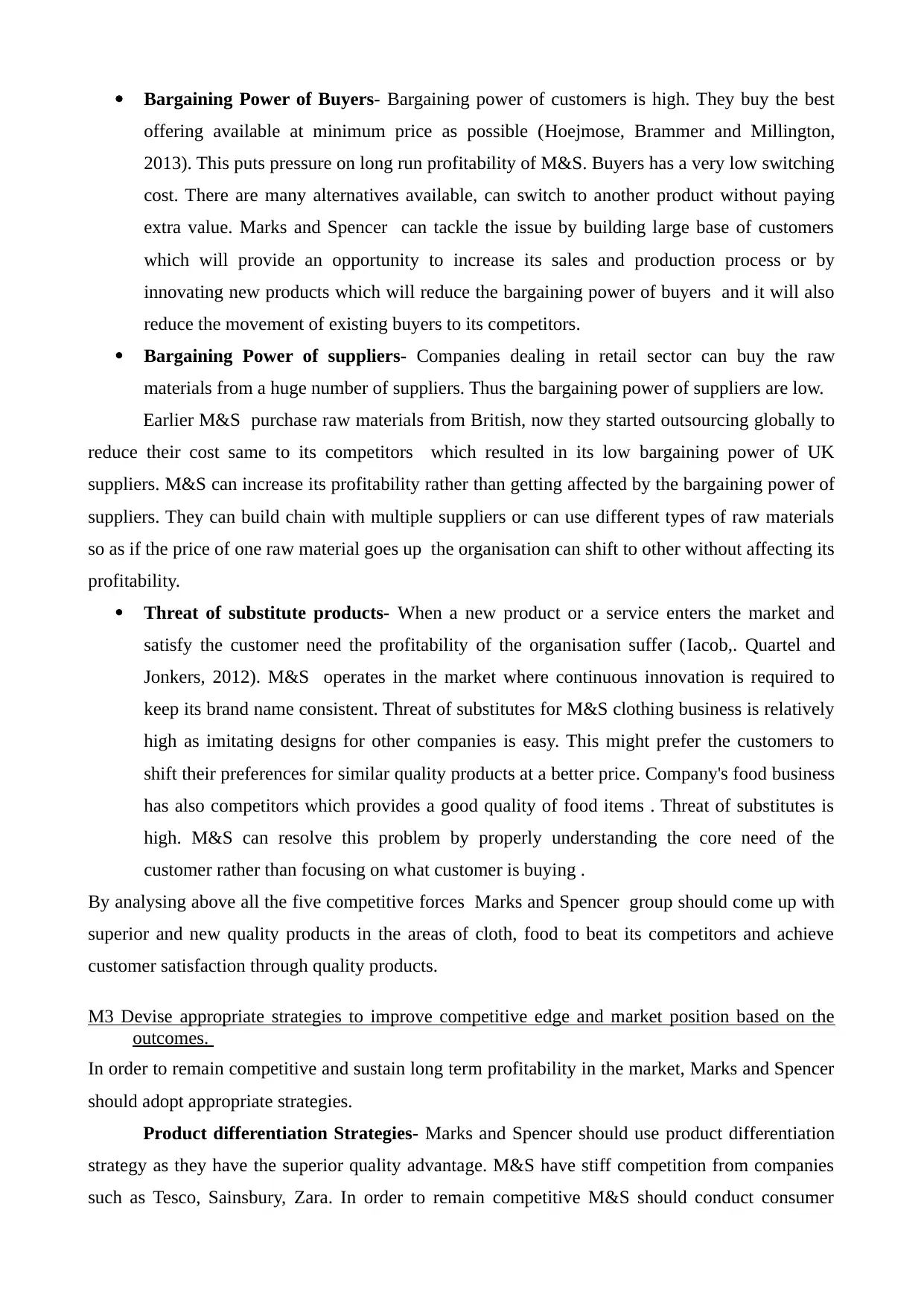
Bargaining Power of Buyers- Bargaining power of customers is high. They buy the best
offering available at minimum price as possible (Hoejmose, Brammer and Millington,
2013). This puts pressure on long run profitability of M&S. Buyers has a very low switching
cost. There are many alternatives available, can switch to another product without paying
extra value. Marks and Spencer can tackle the issue by building large base of customers
which will provide an opportunity to increase its sales and production process or by
innovating new products which will reduce the bargaining power of buyers and it will also
reduce the movement of existing buyers to its competitors.
Bargaining Power of suppliers- Companies dealing in retail sector can buy the raw
materials from a huge number of suppliers. Thus the bargaining power of suppliers are low.
Earlier M&S purchase raw materials from British, now they started outsourcing globally to
reduce their cost same to its competitors which resulted in its low bargaining power of UK
suppliers. M&S can increase its profitability rather than getting affected by the bargaining power of
suppliers. They can build chain with multiple suppliers or can use different types of raw materials
so as if the price of one raw material goes up the organisation can shift to other without affecting its
profitability.
Threat of substitute products- When a new product or a service enters the market and
satisfy the customer need the profitability of the organisation suffer (Iacob,. Quartel and
Jonkers, 2012). M&S operates in the market where continuous innovation is required to
keep its brand name consistent. Threat of substitutes for M&S clothing business is relatively
high as imitating designs for other companies is easy. This might prefer the customers to
shift their preferences for similar quality products at a better price. Company's food business
has also competitors which provides a good quality of food items . Threat of substitutes is
high. M&S can resolve this problem by properly understanding the core need of the
customer rather than focusing on what customer is buying .
By analysing above all the five competitive forces Marks and Spencer group should come up with
superior and new quality products in the areas of cloth, food to beat its competitors and achieve
customer satisfaction through quality products.
M3 Devise appropriate strategies to improve competitive edge and market position based on the
outcomes.
In order to remain competitive and sustain long term profitability in the market, Marks and Spencer
should adopt appropriate strategies.
Product differentiation Strategies- Marks and Spencer should use product differentiation
strategy as they have the superior quality advantage. M&S have stiff competition from companies
such as Tesco, Sainsbury, Zara. In order to remain competitive M&S should conduct consumer
offering available at minimum price as possible (Hoejmose, Brammer and Millington,
2013). This puts pressure on long run profitability of M&S. Buyers has a very low switching
cost. There are many alternatives available, can switch to another product without paying
extra value. Marks and Spencer can tackle the issue by building large base of customers
which will provide an opportunity to increase its sales and production process or by
innovating new products which will reduce the bargaining power of buyers and it will also
reduce the movement of existing buyers to its competitors.
Bargaining Power of suppliers- Companies dealing in retail sector can buy the raw
materials from a huge number of suppliers. Thus the bargaining power of suppliers are low.
Earlier M&S purchase raw materials from British, now they started outsourcing globally to
reduce their cost same to its competitors which resulted in its low bargaining power of UK
suppliers. M&S can increase its profitability rather than getting affected by the bargaining power of
suppliers. They can build chain with multiple suppliers or can use different types of raw materials
so as if the price of one raw material goes up the organisation can shift to other without affecting its
profitability.
Threat of substitute products- When a new product or a service enters the market and
satisfy the customer need the profitability of the organisation suffer (Iacob,. Quartel and
Jonkers, 2012). M&S operates in the market where continuous innovation is required to
keep its brand name consistent. Threat of substitutes for M&S clothing business is relatively
high as imitating designs for other companies is easy. This might prefer the customers to
shift their preferences for similar quality products at a better price. Company's food business
has also competitors which provides a good quality of food items . Threat of substitutes is
high. M&S can resolve this problem by properly understanding the core need of the
customer rather than focusing on what customer is buying .
By analysing above all the five competitive forces Marks and Spencer group should come up with
superior and new quality products in the areas of cloth, food to beat its competitors and achieve
customer satisfaction through quality products.
M3 Devise appropriate strategies to improve competitive edge and market position based on the
outcomes.
In order to remain competitive and sustain long term profitability in the market, Marks and Spencer
should adopt appropriate strategies.
Product differentiation Strategies- Marks and Spencer should use product differentiation
strategy as they have the superior quality advantage. M&S have stiff competition from companies
such as Tesco, Sainsbury, Zara. In order to remain competitive M&S should conduct consumer
Paraphrase This Document
Need a fresh take? Get an instant paraphrase of this document with our AI Paraphraser
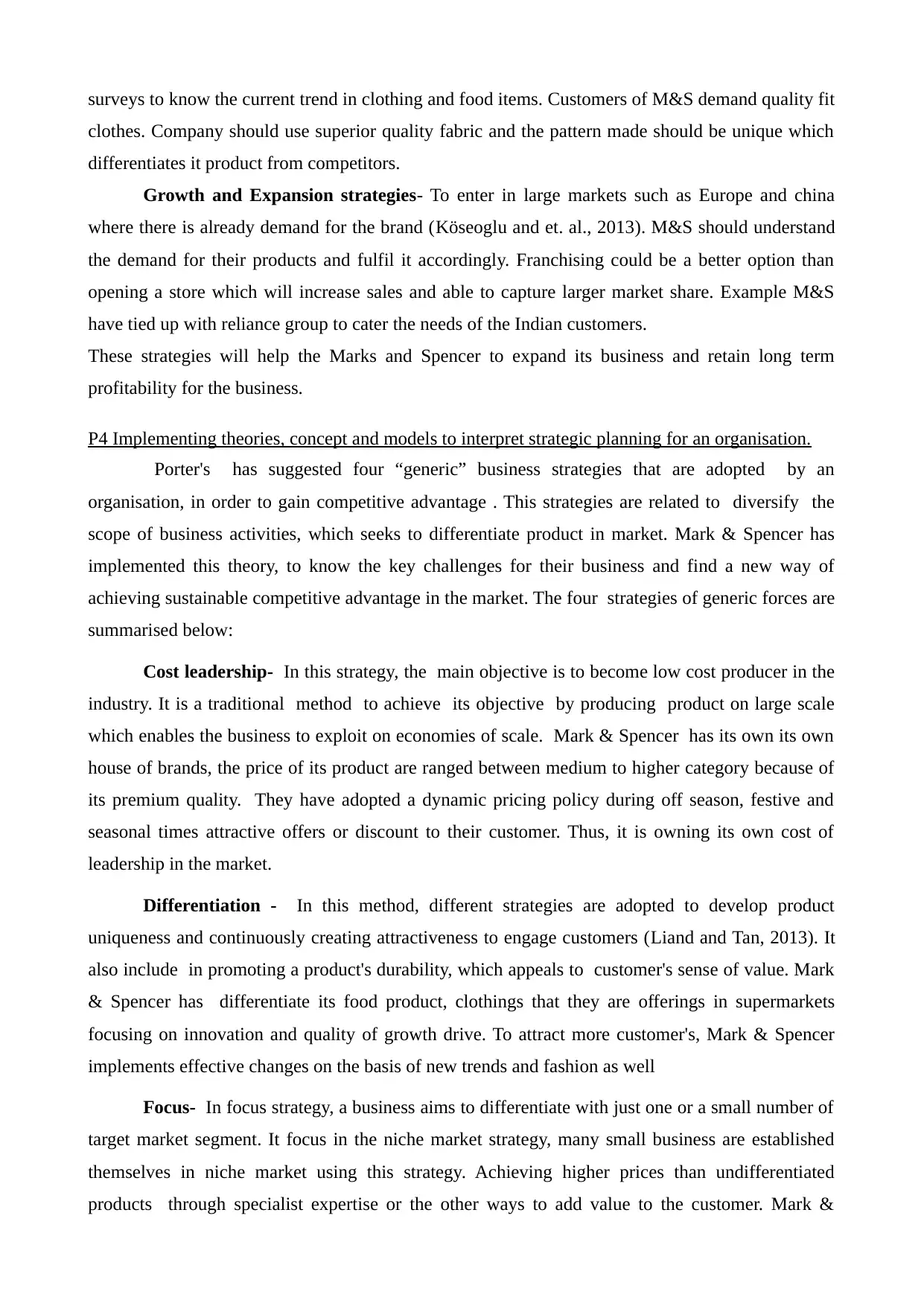
surveys to know the current trend in clothing and food items. Customers of M&S demand quality fit
clothes. Company should use superior quality fabric and the pattern made should be unique which
differentiates it product from competitors.
Growth and Expansion strategies- To enter in large markets such as Europe and china
where there is already demand for the brand (Köseoglu and et. al., 2013). M&S should understand
the demand for their products and fulfil it accordingly. Franchising could be a better option than
opening a store which will increase sales and able to capture larger market share. Example M&S
have tied up with reliance group to cater the needs of the Indian customers.
These strategies will help the Marks and Spencer to expand its business and retain long term
profitability for the business.
P4 Implementing theories, concept and models to interpret strategic planning for an organisation.
Porter's has suggested four “generic” business strategies that are adopted by an
organisation, in order to gain competitive advantage . This strategies are related to diversify the
scope of business activities, which seeks to differentiate product in market. Mark & Spencer has
implemented this theory, to know the key challenges for their business and find a new way of
achieving sustainable competitive advantage in the market. The four strategies of generic forces are
summarised below:
Cost leadership- In this strategy, the main objective is to become low cost producer in the
industry. It is a traditional method to achieve its objective by producing product on large scale
which enables the business to exploit on economies of scale. Mark & Spencer has its own its own
house of brands, the price of its product are ranged between medium to higher category because of
its premium quality. They have adopted a dynamic pricing policy during off season, festive and
seasonal times attractive offers or discount to their customer. Thus, it is owning its own cost of
leadership in the market.
Differentiation - In this method, different strategies are adopted to develop product
uniqueness and continuously creating attractiveness to engage customers (Liand and Tan, 2013). It
also include in promoting a product's durability, which appeals to customer's sense of value. Mark
& Spencer has differentiate its food product, clothings that they are offerings in supermarkets
focusing on innovation and quality of growth drive. To attract more customer's, Mark & Spencer
implements effective changes on the basis of new trends and fashion as well
Focus- In focus strategy, a business aims to differentiate with just one or a small number of
target market segment. It focus in the niche market strategy, many small business are established
themselves in niche market using this strategy. Achieving higher prices than undifferentiated
products through specialist expertise or the other ways to add value to the customer. Mark &
clothes. Company should use superior quality fabric and the pattern made should be unique which
differentiates it product from competitors.
Growth and Expansion strategies- To enter in large markets such as Europe and china
where there is already demand for the brand (Köseoglu and et. al., 2013). M&S should understand
the demand for their products and fulfil it accordingly. Franchising could be a better option than
opening a store which will increase sales and able to capture larger market share. Example M&S
have tied up with reliance group to cater the needs of the Indian customers.
These strategies will help the Marks and Spencer to expand its business and retain long term
profitability for the business.
P4 Implementing theories, concept and models to interpret strategic planning for an organisation.
Porter's has suggested four “generic” business strategies that are adopted by an
organisation, in order to gain competitive advantage . This strategies are related to diversify the
scope of business activities, which seeks to differentiate product in market. Mark & Spencer has
implemented this theory, to know the key challenges for their business and find a new way of
achieving sustainable competitive advantage in the market. The four strategies of generic forces are
summarised below:
Cost leadership- In this strategy, the main objective is to become low cost producer in the
industry. It is a traditional method to achieve its objective by producing product on large scale
which enables the business to exploit on economies of scale. Mark & Spencer has its own its own
house of brands, the price of its product are ranged between medium to higher category because of
its premium quality. They have adopted a dynamic pricing policy during off season, festive and
seasonal times attractive offers or discount to their customer. Thus, it is owning its own cost of
leadership in the market.
Differentiation - In this method, different strategies are adopted to develop product
uniqueness and continuously creating attractiveness to engage customers (Liand and Tan, 2013). It
also include in promoting a product's durability, which appeals to customer's sense of value. Mark
& Spencer has differentiate its food product, clothings that they are offerings in supermarkets
focusing on innovation and quality of growth drive. To attract more customer's, Mark & Spencer
implements effective changes on the basis of new trends and fashion as well
Focus- In focus strategy, a business aims to differentiate with just one or a small number of
target market segment. It focus in the niche market strategy, many small business are established
themselves in niche market using this strategy. Achieving higher prices than undifferentiated
products through specialist expertise or the other ways to add value to the customer. Mark &
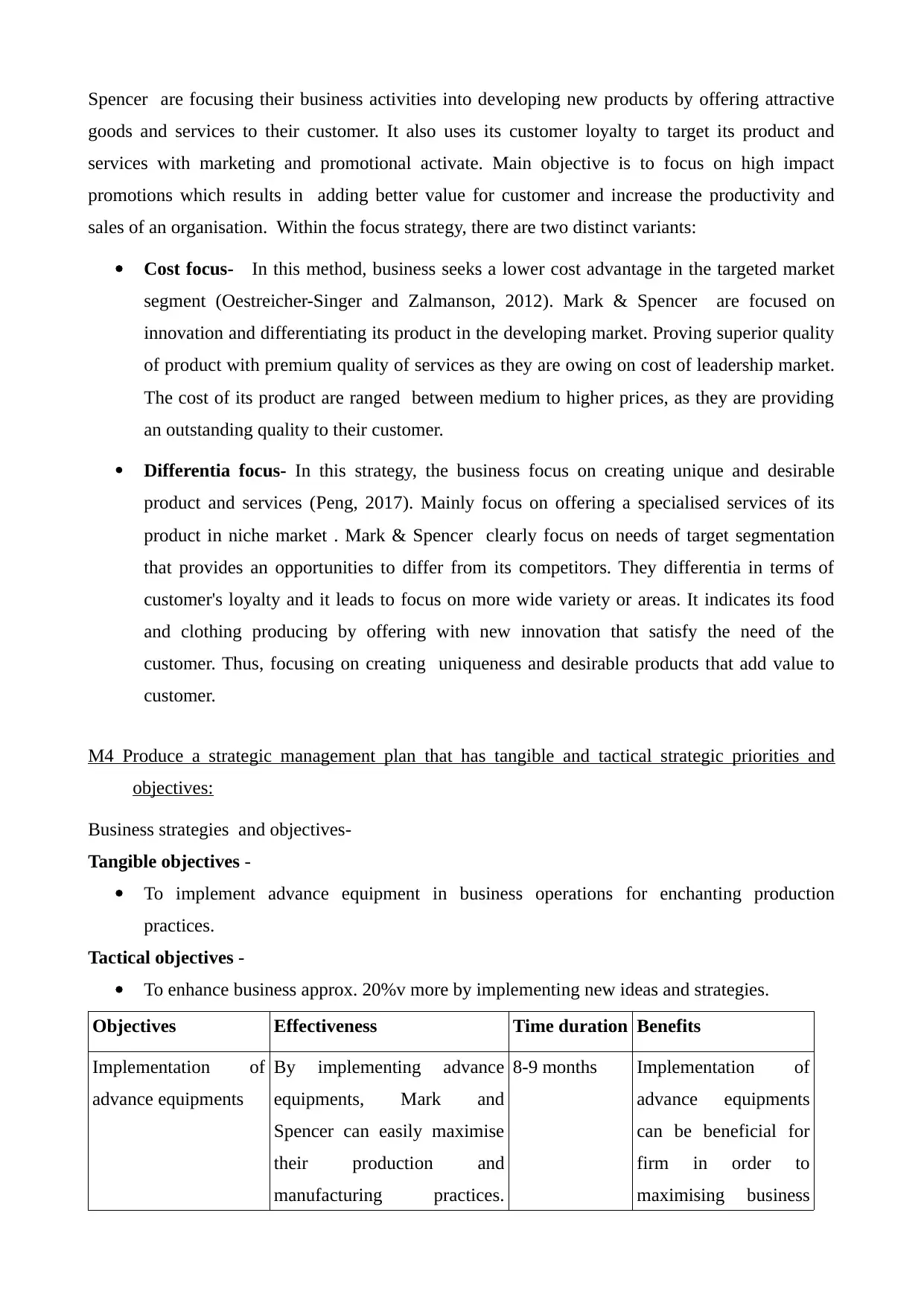
Spencer are focusing their business activities into developing new products by offering attractive
goods and services to their customer. It also uses its customer loyalty to target its product and
services with marketing and promotional activate. Main objective is to focus on high impact
promotions which results in adding better value for customer and increase the productivity and
sales of an organisation. Within the focus strategy, there are two distinct variants:
Cost focus- In this method, business seeks a lower cost advantage in the targeted market
segment (Oestreicher-Singer and Zalmanson, 2012). Mark & Spencer are focused on
innovation and differentiating its product in the developing market. Proving superior quality
of product with premium quality of services as they are owing on cost of leadership market.
The cost of its product are ranged between medium to higher prices, as they are providing
an outstanding quality to their customer.
Differentia focus- In this strategy, the business focus on creating unique and desirable
product and services (Peng, 2017). Mainly focus on offering a specialised services of its
product in niche market . Mark & Spencer clearly focus on needs of target segmentation
that provides an opportunities to differ from its competitors. They differentia in terms of
customer's loyalty and it leads to focus on more wide variety or areas. It indicates its food
and clothing producing by offering with new innovation that satisfy the need of the
customer. Thus, focusing on creating uniqueness and desirable products that add value to
customer.
M4 Produce a strategic management plan that has tangible and tactical strategic priorities and
objectives:
Business strategies and objectives-
Tangible objectives -
To implement advance equipment in business operations for enchanting production
practices.
Tactical objectives -
To enhance business approx. 20%v more by implementing new ideas and strategies.
Objectives Effectiveness Time duration Benefits
Implementation of
advance equipments
By implementing advance
equipments, Mark and
Spencer can easily maximise
their production and
manufacturing practices.
8-9 months Implementation of
advance equipments
can be beneficial for
firm in order to
maximising business
goods and services to their customer. It also uses its customer loyalty to target its product and
services with marketing and promotional activate. Main objective is to focus on high impact
promotions which results in adding better value for customer and increase the productivity and
sales of an organisation. Within the focus strategy, there are two distinct variants:
Cost focus- In this method, business seeks a lower cost advantage in the targeted market
segment (Oestreicher-Singer and Zalmanson, 2012). Mark & Spencer are focused on
innovation and differentiating its product in the developing market. Proving superior quality
of product with premium quality of services as they are owing on cost of leadership market.
The cost of its product are ranged between medium to higher prices, as they are providing
an outstanding quality to their customer.
Differentia focus- In this strategy, the business focus on creating unique and desirable
product and services (Peng, 2017). Mainly focus on offering a specialised services of its
product in niche market . Mark & Spencer clearly focus on needs of target segmentation
that provides an opportunities to differ from its competitors. They differentia in terms of
customer's loyalty and it leads to focus on more wide variety or areas. It indicates its food
and clothing producing by offering with new innovation that satisfy the need of the
customer. Thus, focusing on creating uniqueness and desirable products that add value to
customer.
M4 Produce a strategic management plan that has tangible and tactical strategic priorities and
objectives:
Business strategies and objectives-
Tangible objectives -
To implement advance equipment in business operations for enchanting production
practices.
Tactical objectives -
To enhance business approx. 20%v more by implementing new ideas and strategies.
Objectives Effectiveness Time duration Benefits
Implementation of
advance equipments
By implementing advance
equipments, Mark and
Spencer can easily maximise
their production and
manufacturing practices.
8-9 months Implementation of
advance equipments
can be beneficial for
firm in order to
maximising business
⊘ This is a preview!⊘
Do you want full access?
Subscribe today to unlock all pages.

Trusted by 1+ million students worldwide
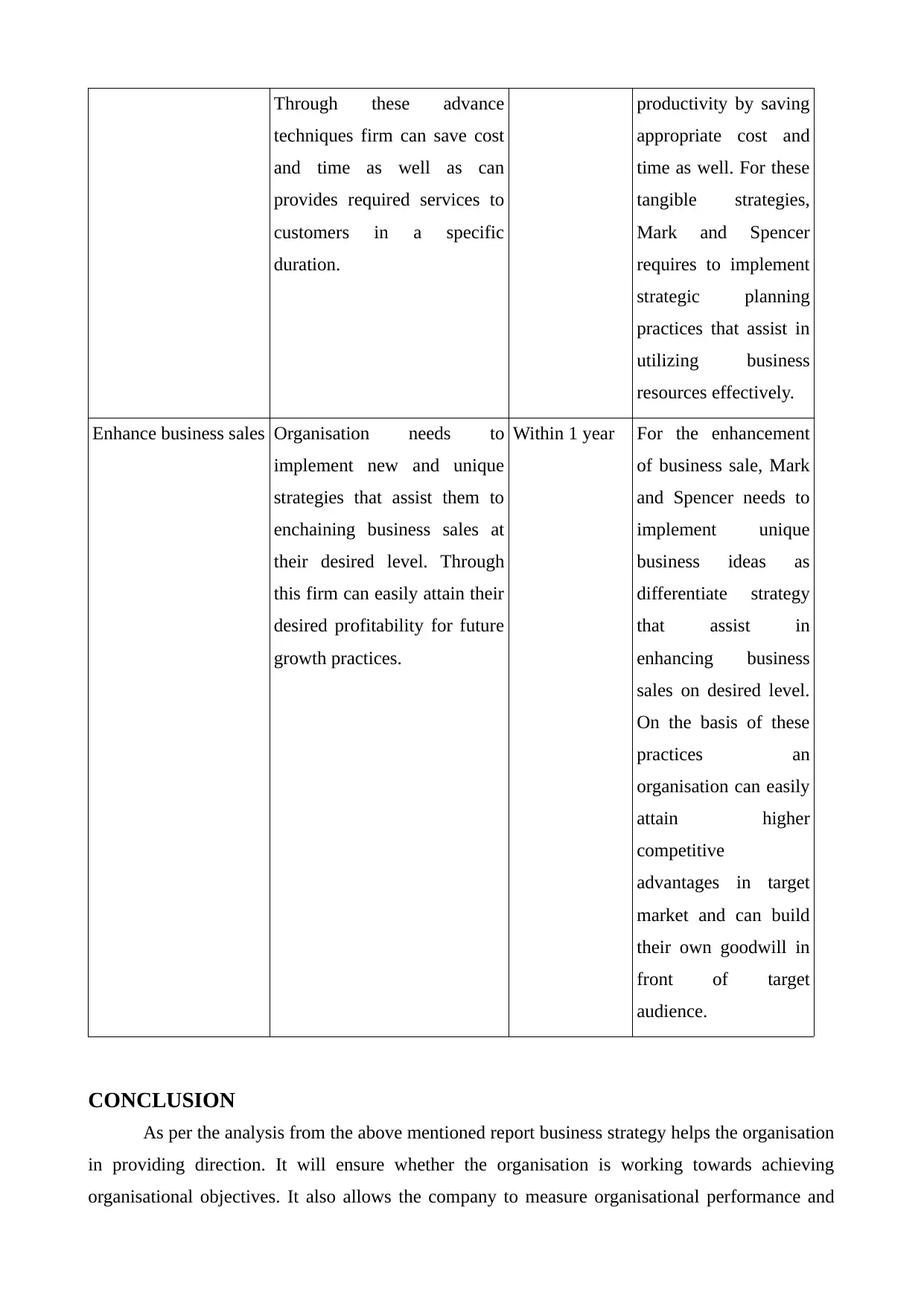
Through these advance
techniques firm can save cost
and time as well as can
provides required services to
customers in a specific
duration.
productivity by saving
appropriate cost and
time as well. For these
tangible strategies,
Mark and Spencer
requires to implement
strategic planning
practices that assist in
utilizing business
resources effectively.
Enhance business sales Organisation needs to
implement new and unique
strategies that assist them to
enchaining business sales at
their desired level. Through
this firm can easily attain their
desired profitability for future
growth practices.
Within 1 year For the enhancement
of business sale, Mark
and Spencer needs to
implement unique
business ideas as
differentiate strategy
that assist in
enhancing business
sales on desired level.
On the basis of these
practices an
organisation can easily
attain higher
competitive
advantages in target
market and can build
their own goodwill in
front of target
audience.
CONCLUSION
As per the analysis from the above mentioned report business strategy helps the organisation
in providing direction. It will ensure whether the organisation is working towards achieving
organisational objectives. It also allows the company to measure organisational performance and
techniques firm can save cost
and time as well as can
provides required services to
customers in a specific
duration.
productivity by saving
appropriate cost and
time as well. For these
tangible strategies,
Mark and Spencer
requires to implement
strategic planning
practices that assist in
utilizing business
resources effectively.
Enhance business sales Organisation needs to
implement new and unique
strategies that assist them to
enchaining business sales at
their desired level. Through
this firm can easily attain their
desired profitability for future
growth practices.
Within 1 year For the enhancement
of business sale, Mark
and Spencer needs to
implement unique
business ideas as
differentiate strategy
that assist in
enhancing business
sales on desired level.
On the basis of these
practices an
organisation can easily
attain higher
competitive
advantages in target
market and can build
their own goodwill in
front of target
audience.
CONCLUSION
As per the analysis from the above mentioned report business strategy helps the organisation
in providing direction. It will ensure whether the organisation is working towards achieving
organisational objectives. It also allows the company to measure organisational performance and
Paraphrase This Document
Need a fresh take? Get an instant paraphrase of this document with our AI Paraphraser
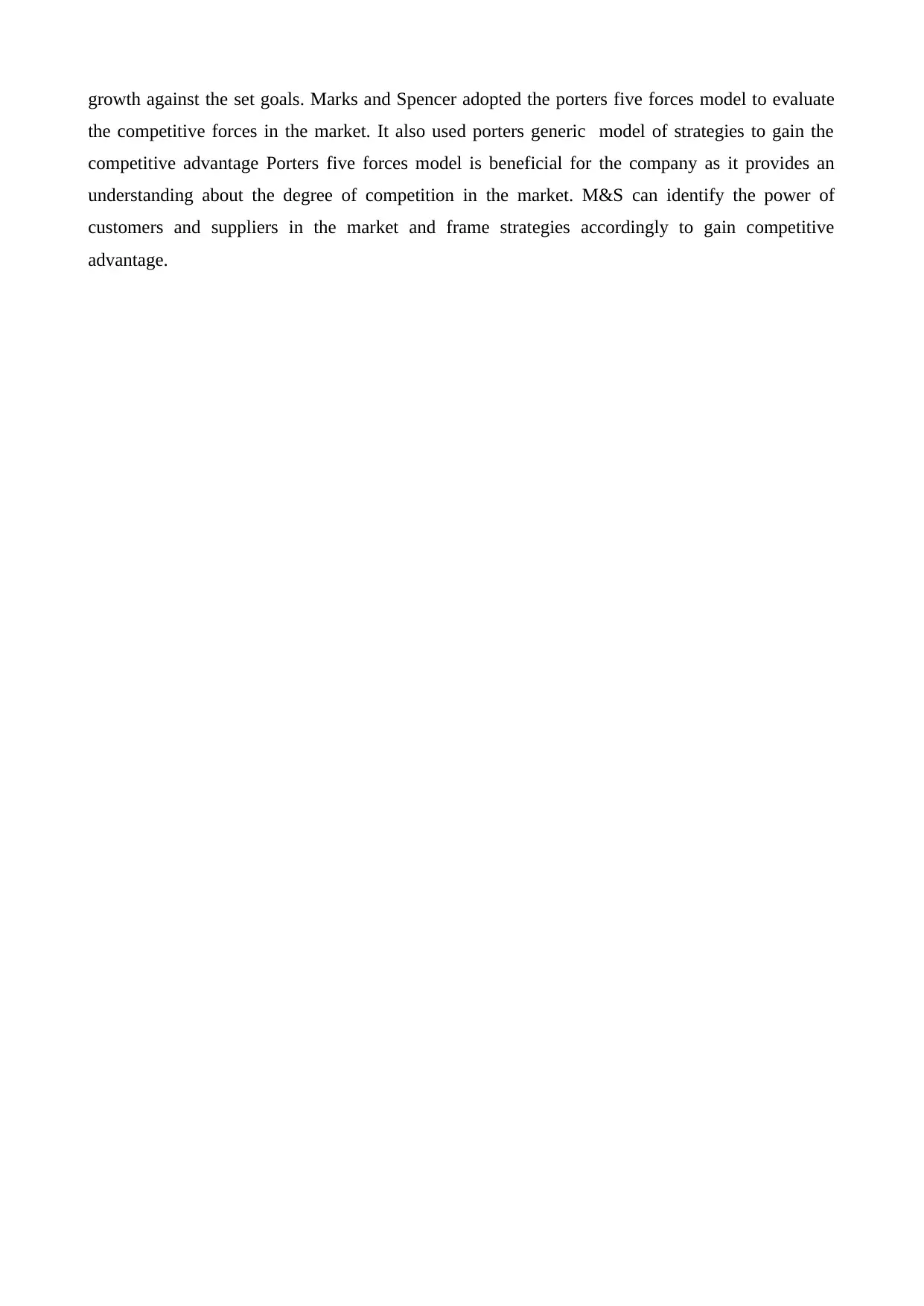
growth against the set goals. Marks and Spencer adopted the porters five forces model to evaluate
the competitive forces in the market. It also used porters generic model of strategies to gain the
competitive advantage Porters five forces model is beneficial for the company as it provides an
understanding about the degree of competition in the market. M&S can identify the power of
customers and suppliers in the market and frame strategies accordingly to gain competitive
advantage.
the competitive forces in the market. It also used porters generic model of strategies to gain the
competitive advantage Porters five forces model is beneficial for the company as it provides an
understanding about the degree of competition in the market. M&S can identify the power of
customers and suppliers in the market and frame strategies accordingly to gain competitive
advantage.
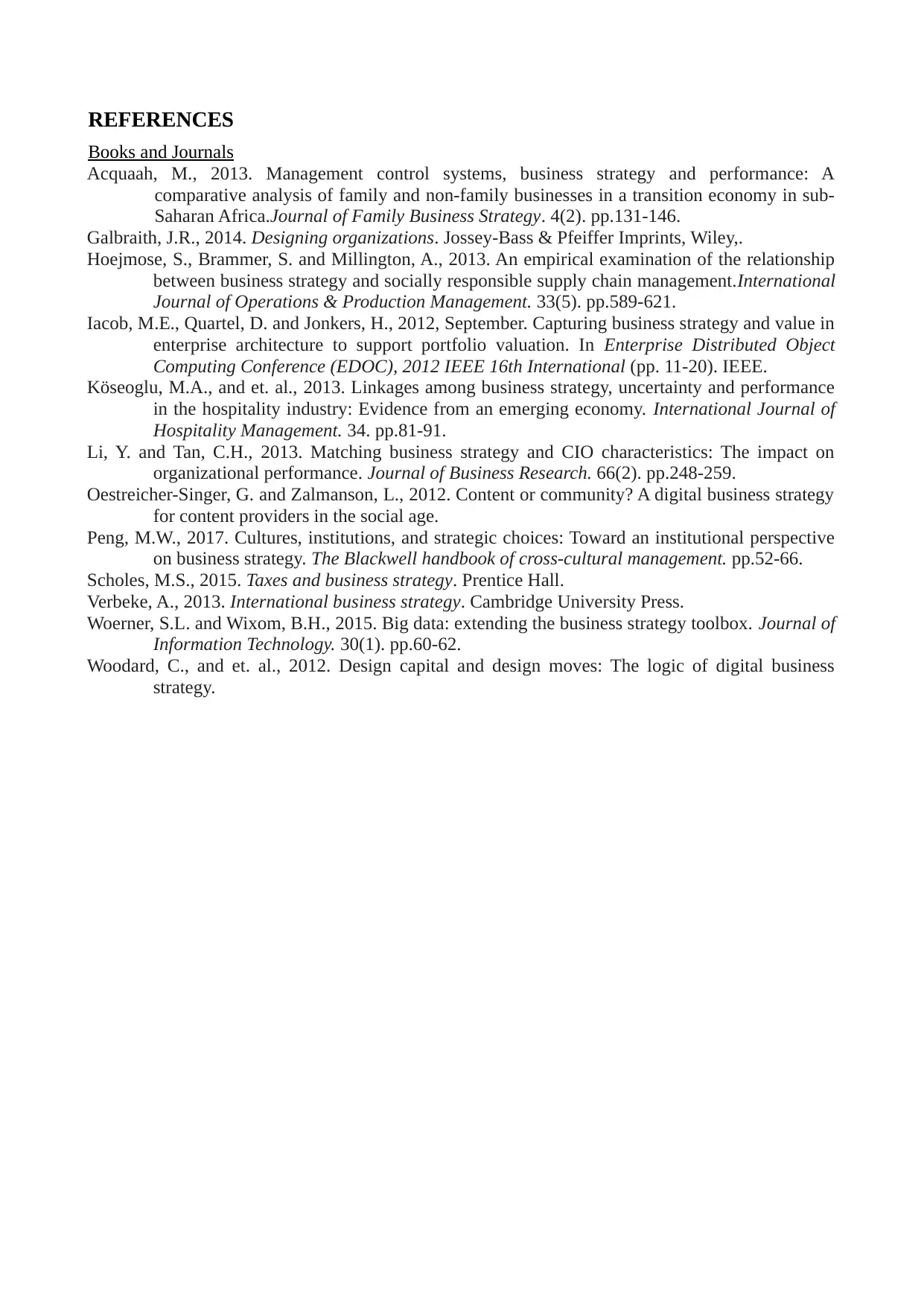
REFERENCES
Books and Journals
Acquaah, M., 2013. Management control systems, business strategy and performance: A
comparative analysis of family and non-family businesses in a transition economy in sub-
Saharan Africa.Journal of Family Business Strategy. 4(2). pp.131-146.
Galbraith, J.R., 2014. Designing organizations. Jossey-Bass & Pfeiffer Imprints, Wiley,.
Hoejmose, S., Brammer, S. and Millington, A., 2013. An empirical examination of the relationship
between business strategy and socially responsible supply chain management.International
Journal of Operations & Production Management. 33(5). pp.589-621.
Iacob, M.E., Quartel, D. and Jonkers, H., 2012, September. Capturing business strategy and value in
enterprise architecture to support portfolio valuation. In Enterprise Distributed Object
Computing Conference (EDOC), 2012 IEEE 16th International (pp. 11-20). IEEE.
Köseoglu, M.A., and et. al., 2013. Linkages among business strategy, uncertainty and performance
in the hospitality industry: Evidence from an emerging economy. International Journal of
Hospitality Management. 34. pp.81-91.
Li, Y. and Tan, C.H., 2013. Matching business strategy and CIO characteristics: The impact on
organizational performance. Journal of Business Research. 66(2). pp.248-259.
Oestreicher-Singer, G. and Zalmanson, L., 2012. Content or community? A digital business strategy
for content providers in the social age.
Peng, M.W., 2017. Cultures, institutions, and strategic choices: Toward an institutional perspective
on business strategy. The Blackwell handbook of cross‐cultural management. pp.52-66.
Scholes, M.S., 2015. Taxes and business strategy. Prentice Hall.
Verbeke, A., 2013. International business strategy. Cambridge University Press.
Woerner, S.L. and Wixom, B.H., 2015. Big data: extending the business strategy toolbox. Journal of
Information Technology. 30(1). pp.60-62.
Woodard, C., and et. al., 2012. Design capital and design moves: The logic of digital business
strategy.
Books and Journals
Acquaah, M., 2013. Management control systems, business strategy and performance: A
comparative analysis of family and non-family businesses in a transition economy in sub-
Saharan Africa.Journal of Family Business Strategy. 4(2). pp.131-146.
Galbraith, J.R., 2014. Designing organizations. Jossey-Bass & Pfeiffer Imprints, Wiley,.
Hoejmose, S., Brammer, S. and Millington, A., 2013. An empirical examination of the relationship
between business strategy and socially responsible supply chain management.International
Journal of Operations & Production Management. 33(5). pp.589-621.
Iacob, M.E., Quartel, D. and Jonkers, H., 2012, September. Capturing business strategy and value in
enterprise architecture to support portfolio valuation. In Enterprise Distributed Object
Computing Conference (EDOC), 2012 IEEE 16th International (pp. 11-20). IEEE.
Köseoglu, M.A., and et. al., 2013. Linkages among business strategy, uncertainty and performance
in the hospitality industry: Evidence from an emerging economy. International Journal of
Hospitality Management. 34. pp.81-91.
Li, Y. and Tan, C.H., 2013. Matching business strategy and CIO characteristics: The impact on
organizational performance. Journal of Business Research. 66(2). pp.248-259.
Oestreicher-Singer, G. and Zalmanson, L., 2012. Content or community? A digital business strategy
for content providers in the social age.
Peng, M.W., 2017. Cultures, institutions, and strategic choices: Toward an institutional perspective
on business strategy. The Blackwell handbook of cross‐cultural management. pp.52-66.
Scholes, M.S., 2015. Taxes and business strategy. Prentice Hall.
Verbeke, A., 2013. International business strategy. Cambridge University Press.
Woerner, S.L. and Wixom, B.H., 2015. Big data: extending the business strategy toolbox. Journal of
Information Technology. 30(1). pp.60-62.
Woodard, C., and et. al., 2012. Design capital and design moves: The logic of digital business
strategy.
⊘ This is a preview!⊘
Do you want full access?
Subscribe today to unlock all pages.

Trusted by 1+ million students worldwide

1 out of 10
Related Documents
Your All-in-One AI-Powered Toolkit for Academic Success.
+13062052269
info@desklib.com
Available 24*7 on WhatsApp / Email
![[object Object]](/_next/static/media/star-bottom.7253800d.svg)
Unlock your academic potential
Copyright © 2020–2025 A2Z Services. All Rights Reserved. Developed and managed by ZUCOL.





